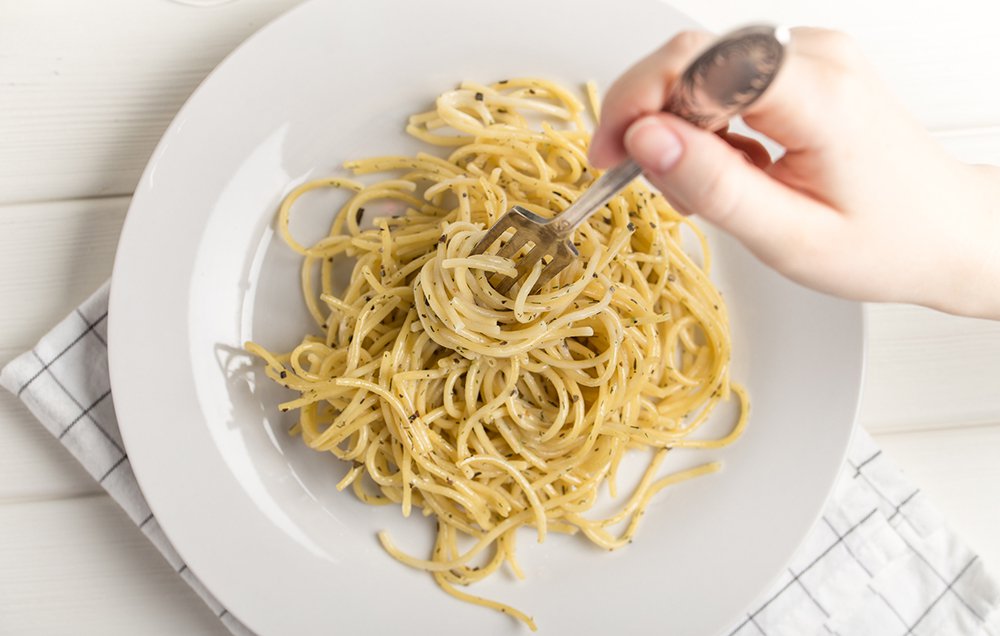The 6 Worst Foods You Can Eat For Dinner, Other Than Takeout

You probably don’t need to be reminded that greasy takeout is doing you zero favors in the health department. But you don’t have to order out for your nighttime meal to be a health nightmare. These common, seemingly-harmless picks aren’t so hot either. Read on to find out what to avoid—and how to make your go-to dinners healthier. (Learn how bone broth can help you lose weight with Women’s Health’s Bone Broth Diet.)

Forget what you see on the front label. Even many so-called healthy frozen dinners are packed with sky-high levels of sodium, and may contain sketchy preservatives like sodium benzoate or butylated hydroxytoluene. Plus, since many frozen meals are meant to serve two or more, you might end up accidentally taking in way more calories than you thought.
If you keep a few frozen meals on hand for busy days when there’s no time to cook, seek out clean, low-sodium options to keep the salt in check and avoid any weird additives. (We love these nutritionist-approved picks from Trader Joe’s.) And always check the serving size before filling up your plate.

That pasta and marinara might look like a respectable meal. But it’s really more like dessert on a dinner plate. White pasta is practically devoid of nutrition and full of refined carbs, which your body converts into sugar. As for the sauce? It’s not much better than when Buddy the Elf pours maple syrup on his spaghetti. Most jarred sauces serve up around two teaspoons of sugar per serving—around a third of what you should have in a day.
When you’re in the mood for Italian, pick whole wheat pasta and toss it with homemade sauce. Make sure to add in some protein (like turkey meatballs, tuna, or white beans) to make the meal more filling, too.
Looking for more nutritious spaghetti options? Try these seven tasty takes on zoodles:

A bowl of O’s or flakes isn’t the best choice for breakfast—and it’s not a great idea for dinner, either. For starters, most packaged cereals are high in sugar and low in protein and fiber. And at 200 to 300 calories per serving (with the milk), it just isn’t a lot of food for dinner—which means you might find your stomach rumbling before bed.
If cereal is really your only option, at least go for a clean one with more than five grams fiber and less than 10 grams sugar per serving. And add in a few extras to up the nutrition and make it more filling, like a spoonful of nut butter and some fresh fruit.
RELATED: 7 Foods You Should Definitely Avoid At Breakfast

Hot peppers can help rev your metabolism, promote healthy blood sugar levels, and even help protect your heart. But you might want to save that fiery salsa or curry for earlier in the day. Spicy foods can raise your body temperature, and they have a tendency to aggravate acid reflux or lead to indigestion. Which may be why some research shows that eating them before bed can lead to poorer sleep.
Related: 8 Great—And Not-So-Great—Things Spicy Food Does To Your Body

It’s quick, easy, and comforting. But sorry, it’s not really dinner. The white bread and jelly are really just sugar in disguise. And even though the peanut butter is rich in protein and healthy fat, it’s easy to overdo it. So you end up with a 600-calorie meal that delivers little in the way of real nutrition.
When you’ve got PB&J on the brain (or just don’t feel like cooking), opt for whole wheat bread and zero added sugar jam. Consider using almond butter instead of peanut butter—though both offer the same amount of protein and fat, almond butter serves up significantly more vitamin E, magnesium, and calcium. And enjoy that sammie with a side of fresh fruit or veggies.

A simple garden salad might seem like a smart pick. And it is—for a side dish. Even a big bowl of veggies doesn’t have enough protein or calories to keep you full for more than an hour or two, leaving you tempted to raid the pantry for junky snacks before bed. Plus, that bottled dressing isn’t doing you any good: Most are loaded with added sugars and chemical emulsifiers.
If you want to have salad for dinner, great. But make sure it has a healthy shot of lean protein (like chicken or turkey, salmon or tuna, tofu, or beans) and a serving or two of healthy fat (like avocado, or nuts). Dress it with simple olive oil and vinegar, or consider shaking up a bottle of homemade dressing. Want to up the nutrition factor even more? Swap out the lettuce for darker greens like baby spinach or kale.
The article The 6 Worst Foods You Can Eat For Dinner, Other Than Takeout originally appeared on Prevention.






